Abstract
Purified nuclear DNA from two mealybug species was analyzed for its 5-methylcytosine (m5C) content by reversed-phase high-pressure liquid chromatography. We observed that the percent m5C (percentage of cytosines which are methylated) varied between the two species, between males and females of the same species, and between lines with and without supernumerary B chromosomes. This is the first case of a sex-specific difference in overall DNA methylation level. In contrast to a recent report (Deobagkar et al., J. Biosci. [India] 4:513-526, 1982), we found no other modified bases in the DNA. Overall, the percent m5C in Pseudococcus obscurus was two to three times higher than in Pseudococcus calceolariae. In both species, the percent m5C in males was higher than in females, although only in P. calceolariae was the difference statistically significant (0.68 +/- 0.02 versus 0.44 +/- 0.04). The high m5C content in males was correlated with the presence of a paternally derived, genetically inactive set of chromosomes which is facultatively heterochromatic. The presence of constitutive heterochromatin, however, was associated with a lower m5C content. Thus, for example, the percent m5C in females of a P. obscurus line with heterochromatic B chromosomes (1.09 +/- 0.04) was significantly lower than that of a related line lacking such chromosomes (1.26 +/- 0.06). Our findings are discussed with respect to the possible relationship between DNA methylation and heterochromatization.
Full text
PDF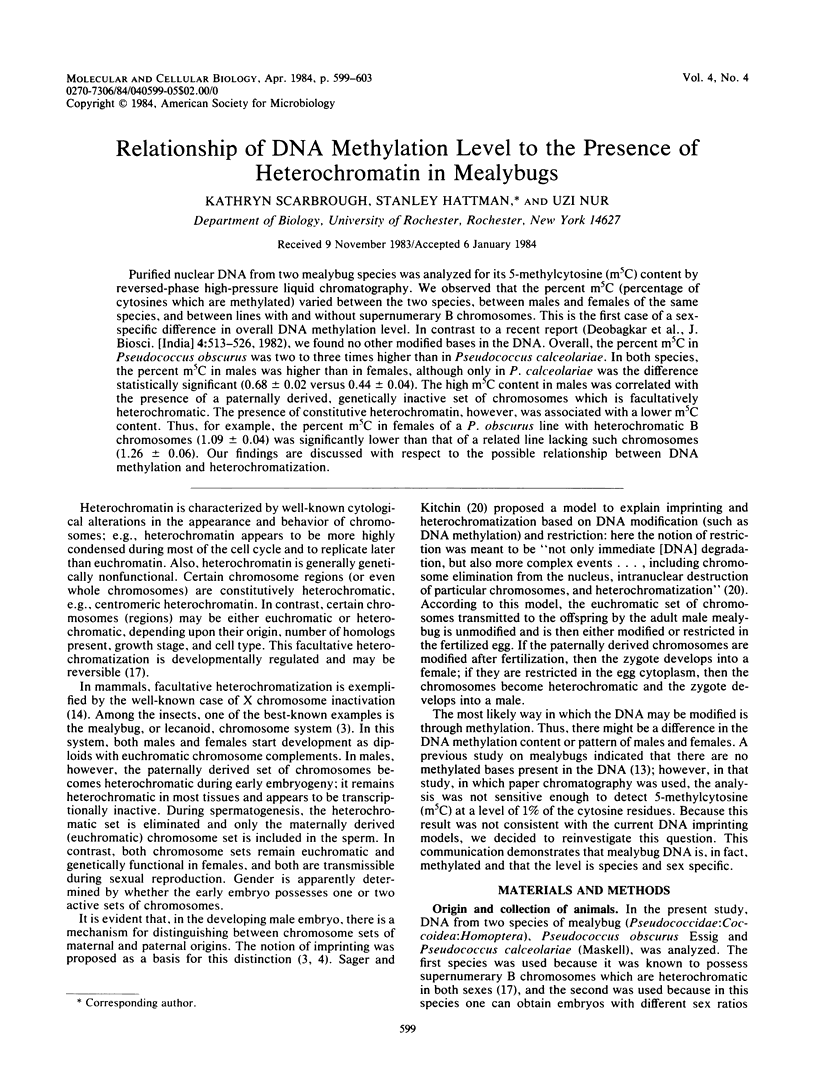
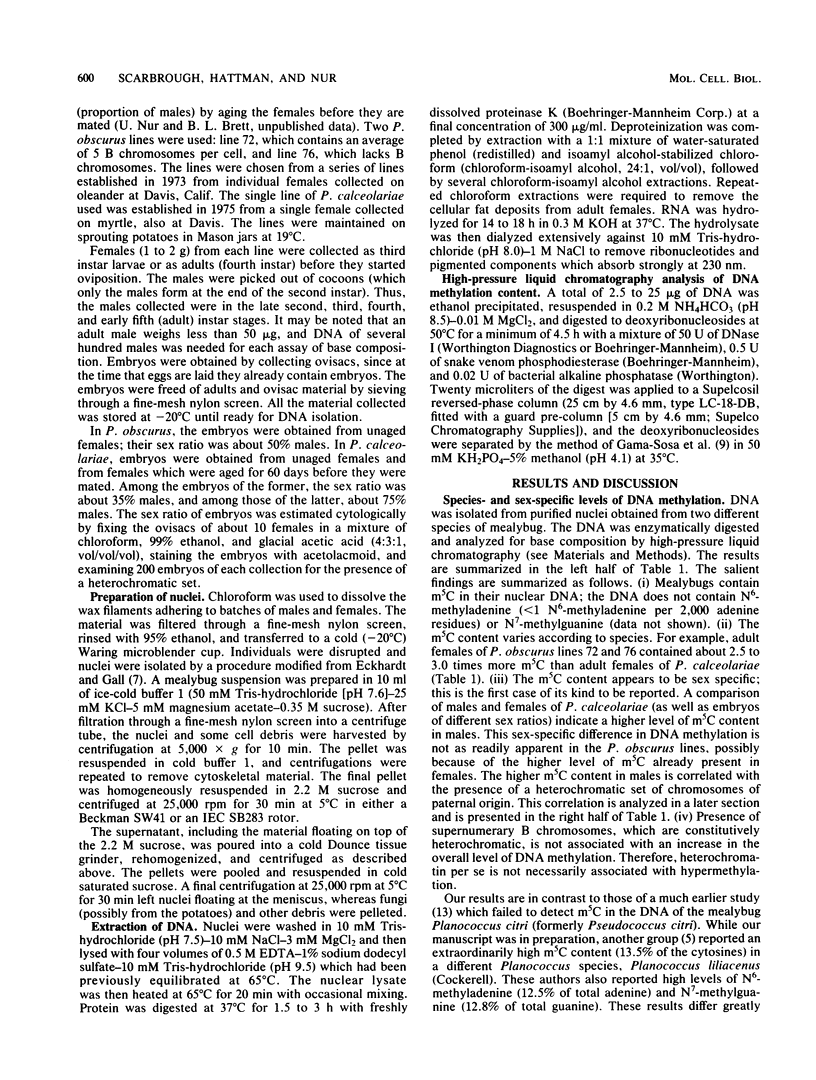
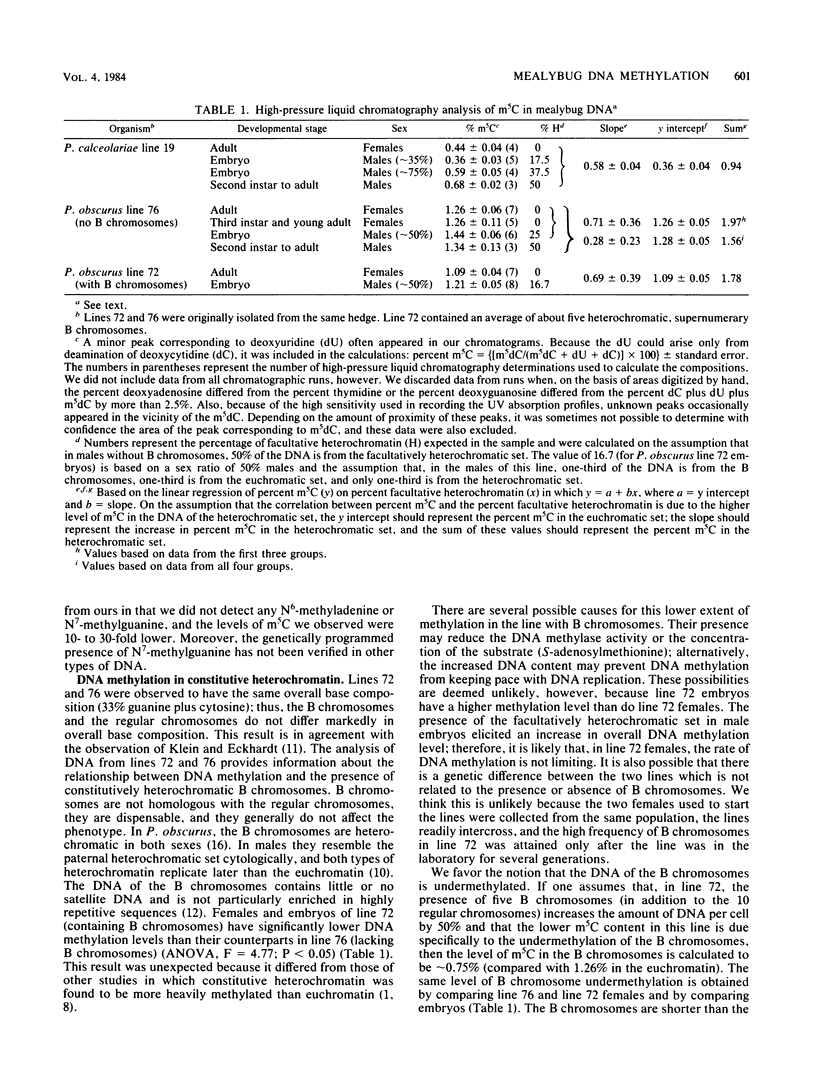
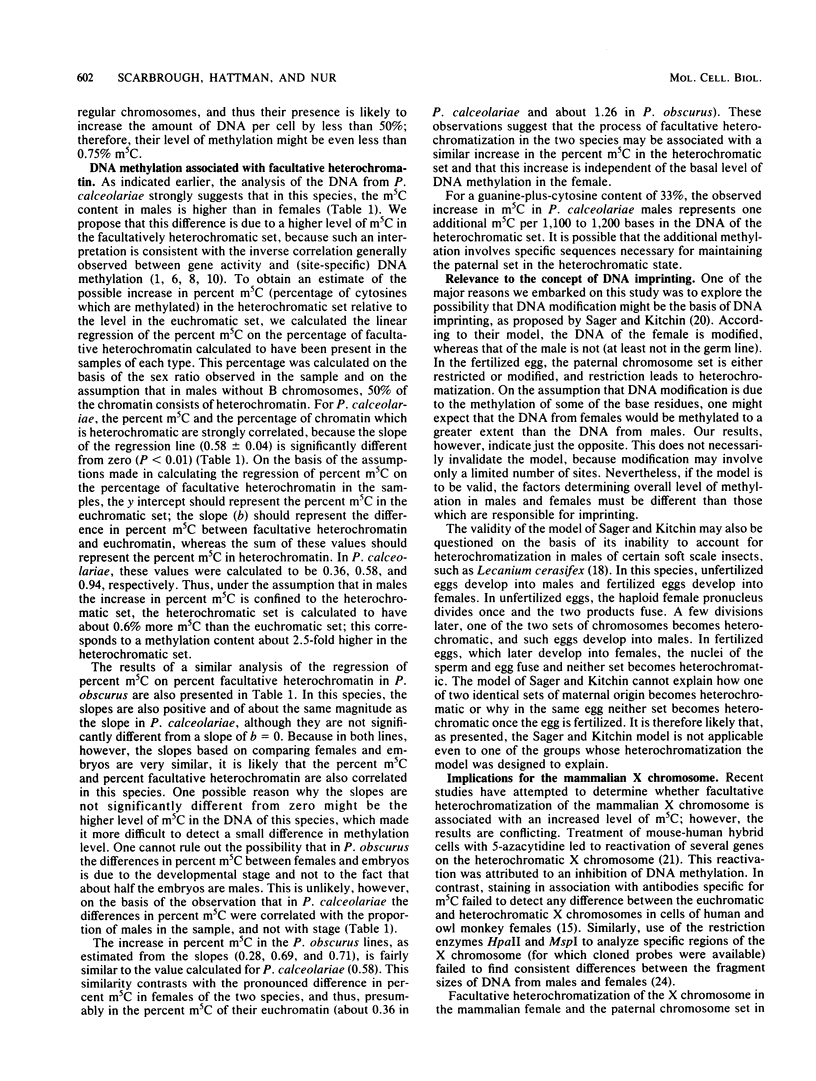
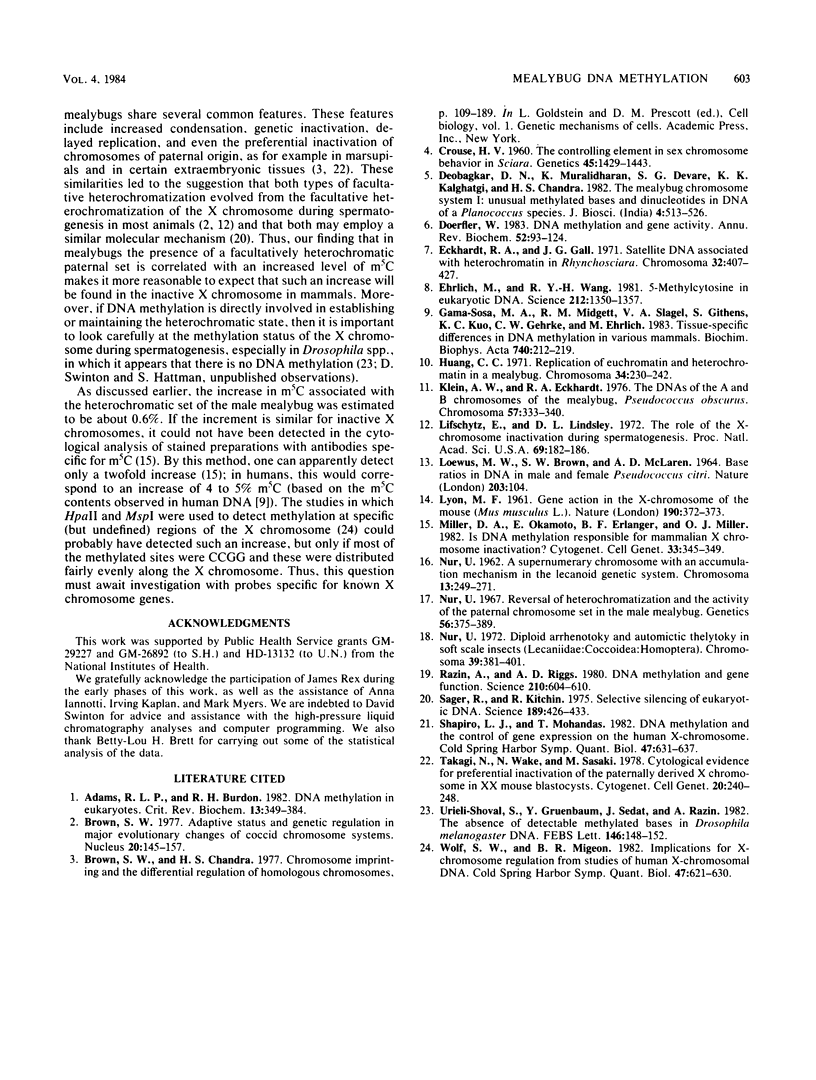
Selected References
These references are in PubMed. This may not be the complete list of references from this article.
- Adams R. L., Burdon R. H. DNA methylation in eukaryotes. CRC Crit Rev Biochem. 1982;13(4):349–384. doi: 10.3109/10409238209108714. [DOI] [PubMed] [Google Scholar]
- Crouse H V. The Controlling Element in Sex Chromosome Behavior in Sciara. Genetics. 1960 Oct;45(10):1429–1443. doi: 10.1093/genetics/45.10.1429. [DOI] [PMC free article] [PubMed] [Google Scholar]
- Doerfler W. DNA methylation and gene activity. Annu Rev Biochem. 1983;52:93–124. doi: 10.1146/annurev.bi.52.070183.000521. [DOI] [PubMed] [Google Scholar]
- Eckhardt R. A., Gall J. G. Satellite DNA associated with heterochromatin in Rhynchosciara. Chromosoma. 1971 Mar 16;32(4):407–427. doi: 10.1007/BF00285252. [DOI] [PubMed] [Google Scholar]
- Ehrlich M., Wang R. Y. 5-Methylcytosine in eukaryotic DNA. Science. 1981 Jun 19;212(4501):1350–1357. doi: 10.1126/science.6262918. [DOI] [PubMed] [Google Scholar]
- Gama-Sosa M. A., Midgett R. M., Slagel V. A., Githens S., Kuo K. C., Gehrke C. W., Ehrlich M. Tissue-specific differences in DNA methylation in various mammals. Biochim Biophys Acta. 1983 Jun 24;740(2):212–219. doi: 10.1016/0167-4781(83)90079-9. [DOI] [PubMed] [Google Scholar]
- Huang C. C. Replication of euchromatin and heterochromatin in a mealybug. Chromosoma. 1971;34(2):230–242. doi: 10.1007/BF00285188. [DOI] [PubMed] [Google Scholar]
- Klein A. S., Eckhardt R. A. The DNAs of the A and B chromosomes of the mealy bug, Pseudococcus obscurus. Chromosoma. 1976 Sep 24;57(4):333–340. doi: 10.1007/BF00332158. [DOI] [PubMed] [Google Scholar]
- LOEWUS M. W., BROWN S. W., MCLAREN A. D. BASE RATIOS IN DNA IN MALE AND FEMALE PSEUDOCOCCUS CITRI. Nature. 1964 Jul 4;203:104–104. doi: 10.1038/203104a0. [DOI] [PubMed] [Google Scholar]
- LYON M. F. Gene action in the X-chromosome of the mouse (Mus musculus L.). Nature. 1961 Apr 22;190:372–373. doi: 10.1038/190372a0. [DOI] [PubMed] [Google Scholar]
- Lifschytz E., Lindsley D. L. The role of X-chromosome inactivation during spermatogenesis (Drosophila-allocycly-chromosome evolution-male sterility-dosage compensation). Proc Natl Acad Sci U S A. 1972 Jan;69(1):182–186. doi: 10.1073/pnas.69.1.182. [DOI] [PMC free article] [PubMed] [Google Scholar]
- Miller D. A., Okamoto E., Erlanger B. F., Miller O. J. Is DNA methylation responsible for mammalian X chromosome inactivation? Cytogenet Cell Genet. 1982;33(4):345–349. doi: 10.1159/000131782. [DOI] [PubMed] [Google Scholar]
- Nur U. Reversal of heterochromatization and the activity of the paternal chromosome set in the male mealy bug. Genetics. 1967 Jul;56(3):375–389. doi: 10.1093/genetics/56.3.375. [DOI] [PMC free article] [PubMed] [Google Scholar]
- Razin A., Riggs A. D. DNA methylation and gene function. Science. 1980 Nov 7;210(4470):604–610. doi: 10.1126/science.6254144. [DOI] [PubMed] [Google Scholar]
- Sager R., Kitchin R. Selective silencing of eukaryotic DNA. Science. 1975 Aug 8;189(4201):426–433. [PubMed] [Google Scholar]
- Shapiro L. J., Mohandas T. DNA methylation and the control of gene expression on the human X chromosome. Cold Spring Harb Symp Quant Biol. 1983;47(Pt 2):631–637. doi: 10.1101/sqb.1983.047.01.074. [DOI] [PubMed] [Google Scholar]
- Takagi N., Wake N., Sasaki M. Cytologic evidence for preferential inactivation of the paternally derived X chromosome in XX mouse blastocysts. Cytogenet Cell Genet. 1978;20(1-6):240–248. doi: 10.1159/000130856. [DOI] [PubMed] [Google Scholar]
- Urieli-Shoval S., Gruenbaum Y., Sedat J., Razin A. The absence of detectable methylated bases in Drosophila melanogaster DNA. FEBS Lett. 1982 Sep 6;146(1):148–152. doi: 10.1016/0014-5793(82)80723-0. [DOI] [PubMed] [Google Scholar]
- Wolf S. F., Migeon B. R. Implications for X-chromosome regulation from studies of human X-chromosome DNA. Cold Spring Harb Symp Quant Biol. 1983;47(Pt 2):621–630. doi: 10.1101/sqb.1983.047.01.073. [DOI] [PubMed] [Google Scholar]


